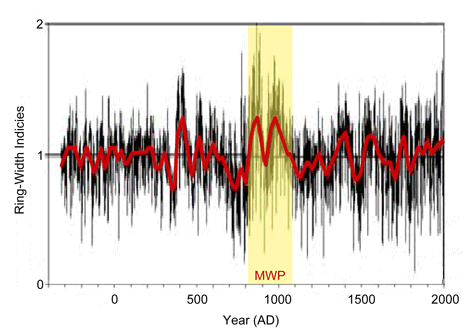Reference
Zhang, Q.-B., Cheng, G., Yao, T., Kang, X. and Huang, J. 2003. A 2,326-year tree-ring record of climate variability on the northeastern Qinghai-Tibetan Plateau. Geophysical Research Letters 30: 10.1029/2003GL017425.
Background
In prefacing the body of their intriguing paper, the authors indicate that "there has been considerable uncertainty as to the amplitude, synchroneity and spatial extent of many climate fluctuations, such as the Medieval Warm Period (MWP) and the Little Ice Age (LIA)."
What was done
In an effort to help resolve this uncertainty, Zhang et al. collected tree-ring samples of well-preserved Sabina przewalskii tree trunks, which had been used as building blocks in ancient tombs in the Dulan area (35°50' ~ 36°30'N, 97°40' ~ 98°20'E) of the Qinghai-Tibetan Plateau. In addition, they collected core samples from tree trunks employed in building local cabins, as well as from living sabina trees in the same area, in order to (1) crossdate the annual growth rings of the ancient tree trunks and (2) establish the climate- growth relationship of the trees, which latter feat was accomplished using regional means of climatic data measured at three nearby meteorological stations over the period 1953-2000.
What was learned
The five Chinese scientists report that their annually-resolved 2,326-year tree-ring chronology (stretching from 326 BC to AD 2000) was "most strongly correlated with the spring precipitation (May-June, r = 0.58, p < 0.001)," which indicates, in their words, that "moisture stress in [the] growing season is a major limiting factor to tree-ring growth." In addition, they state that "this result is in general agreement with that observed in dendro-climatological studies of the same species in other areas of the Qinghai-Tibetan Plateau, suggesting that the annual growth rings mainly reflect variations in regional spring precipitation." As shown by the graphical representation of their data in the figure below, therefore, we conclude that the MWP in the Dulan area (as defined by spring precipitation) held sway from approximately AD 820 to AD 1100.

Sabina przewalskii ring-width indices vs. year, derived from trees of the Dulan area of the Qinghai-Tibetan Plateau. Adapted from Zhang et al. (2003).
With respect to the data depicted above, Zhang et al. additionally say that "corresponding to the North Atlantic MWP, the ring widths were increased ... during AD 929-1031, with the peak occurring around AD 974." And they go on to state that these observations mesh well with what Esper et al. (2002) had found, i.e., that "long tree-ring chronologies in the Northern Hemisphere extra-tropics ... indicated that the warmest period covers the interval AD 950-1045, with the peak occurring around AD 990."
What it means
Zhang et al. conclude that their proxy climate data "reveal that the North Atlantic MWP and the LIA were accompanied by climate changes on the northeastern Qinghai-Tibetan Plateau," while their comparison with Esper et al.'s data indicates that their data are also well correlated with long tree-ring chronologies from much of the Northern Hemisphere. The research team thus provides important evidence for the broad geographical reach of both the MWP and the LIA, which indicates that these climatic phenomena extended far beyond the North Atlantic Ocean and the lands immediately surrounding it.
Reference
Esper, J., Cook, E.R. and Schweingruber, F.H. 2002. Low-frequency signals in long tree-ring chronologies for reconstructing past temperature variability. Science 295: 2250-2253.




